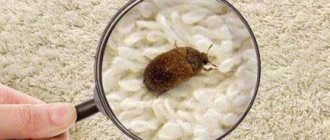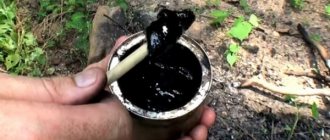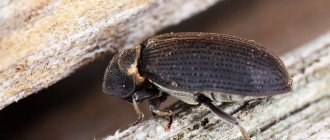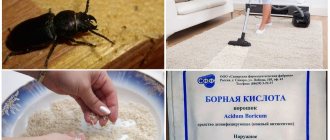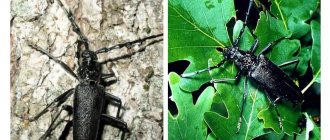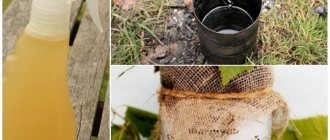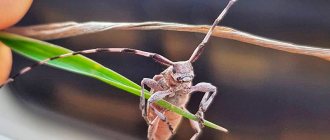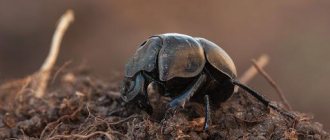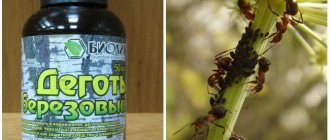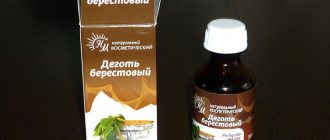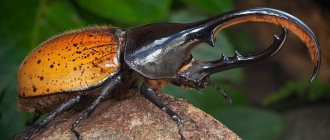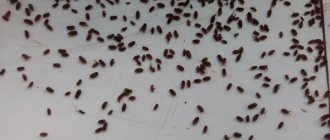Birch sapwood belongs to the bark beetle family and is one of its largest representatives. The body of an adult is black, shiny, its length is 4.5-6.5 mm, the antennae and legs are brown. Bark beetles are characterized by weak sexual dimorphism. The male differs from the female by the presence of dense long hairs on the forehead.
Representatives of both sexes have a short longitudinal keel above the jaws; in males there is a small rounded depression between the eyes. The shield is evenly dotted with small dots. On the flat elytra, longitudinal furrows of coarse punctation are clearly visible, with small dots in the spaces between them. In the posterior part of the elytra, the edges are smooth without any relief. Well developed membranous wings.
The abdominal segments are slanted upward; in males, on the third abdominal segment there is a relatively large tubercle resembling a button. On the fourth segment, two closely spaced tubercles merged into a larger formation with a notch in the center. The abdominal segments of females are smooth without any thickening. The antennal flagellum consists of seven segments and is crowned with a three-membered flat club of oval shape.
Types of sapwood and regions of distribution
200 species of weevils are included in the biological group of pests of fruit crops in the Northern Hemisphere and South America, and 50 of them are presented in the classifier for our country (read in detail about pests of apple trees here).
These insects “specialize” in both cultivated (apple, pear, etc.) and wild plants - mountain ash, hawthorn, dogwood, deciduous and coniferous trees.
All periods of beetle development take place in the vitally active layer of the tree, and therefore cause irreparable damage to it , boring through numerous passages, clogging them with a drill plug, destroying cambium cells (providing growth of trunk tissue), causing gum formation.
For your information: One sapwood beetle bores up to 3 burrows 6 cm long during its life. The fertility of one female is up to 100 eggs. You can imagine the damage caused by just one generation of these pests.
Almost every tree species has its own wood-boring beetle (monophagous), which prefers these particular plants to ensure its existence:
- fruit sapwood;
- birch sapwood;
- oak sapwood;
- almond;
- hornbeam, etc.
Some species show preference for the region of distribution:
- Ussuri;
- Morawica sapwood (Dauria, northeast China).
Species diversity is also ensured by the morphological characteristics of the pest:
- pygmy sapwood;
- wrinkled-faced;
- sapwood-swordtail.
Interesting: Sapwood is not only the favorite delicacy of the sapwood, it was traditionally included in the Yakut diet.
Insidious pests in the garden can cause great damage to fruit trees, reduce the yield, or even completely eliminate it. It is very important to know how to deal with dangerous insects. On our website, in a number of publications, we talked about some of the pests of apple trees: gypsy and ringed silkworms, leafminer moths, apple and oriental codling moths, and the beautiful, but very dangerous for trees, hawthorn butterfly.
Garden pests
Sapwood larvae live in the bark of trees, making numerous tunnels in it. In the spring, when fruit crops bloom, pupation occurs.
The emerging beetles, in order to break out and continue their lineage, make almost perfect circular holes in the bark. It is easy to tell from them that the garden is suffering from sapwood.
Pathogenic microorganisms: bacteria and fungi easily penetrate into the plant through the holes, which leads to secondary diseases. Gnawing through the bast, one of the layers of bark, causes the branches to die off, followed by the death of the tree. The third aspect of harm from sapwood is gum formation in stone fruits, that is, the leakage of sticky liquid: brown, yellow or transparent. This is caused by beetles gnawing out areas in the forks of branches and around the buds. As a result, the buds and young shoots of the tree die.
Description of fruit type
- Fruit sapwood is a dark brown oligophagous beetle:
- up to 4 mm in size;
- with shiny elytra and equilateral pronotum;
- abdomen of 8 segments, straight, oblique;
- the small head seems to be pulled into the chest;
- antennae with oval thickenings at the ends (clubs), densely covered with hairs;
- six tarsi with an apical tooth on the tibia;
- with abundant covering of hairs and scales throughout the body.
- The species is characterized by sexual dimorphism.
- The eggs are white, oval in shape, up to 1 mm in size each. There are 50-100 eggs in a clutch.
- The larva is white, soft, with a yellowish tint, up to 5 mm in size; with callus-like pads that provide it with movement; significant individual - dark brown;
- Pupa is a white metamorphosis of a beetle, corresponding to its size; a dense, short formation, with strongly protruding wings that hide the legs.
Fact: The sapwood of fruit trees, mainly stone fruits, is attacked by another beetle - the wrinkled sapwood. It is smaller in size (up to 3 mm) and coal black without shine. His flights in search of a new home begin a month later - from July to August.
Research methodology
Based on information obtained from the processing of literary data, an annotated list of bark beetles of the Bobruisk region was compiled, including 23 species.
The taxonomic structure of the family has been studied. To characterize the habitats, the descriptive nomenclature of K.B. Gorodkova (1984), which allows for zoogeographic analysis based on a unified terminological approach.
Photographs of bark beetle damage on various trees were taken, identified and described according to Stark.
Insects were collected from May to August. For this, three biotopes were selected: biotope No. 1 - mixed forest, biotope No. 2 - pine forest, biotope No. 3 - mixed forest - roadside.
Collection was carried out on damaged trees. At the same time, the bark was removed from the tree and examined for the presence of various Coleoptera. The found specimens were placed in a fixative (92% ethyl alcohol). The collected material was determined in laboratory conditions. Subsequently, fixation was carried out using entomological pins.
Photo
You can see what the sapwood looks like in the photo below:
Characteristic
The bark beetle is a small beetle whose body length, depending on the species of the insect, can range from 0.8 to 9 mm. On the head, which is retracted into the prothorax, there are geniculate antennae with a large club at the end. Stiff bristles are clearly visible on the carapace and thin legs, and dotted grooves are visible on the elytra. The forehead can be completely flat, concave or convex, which depends on the sex of the insect, for example, in males the surface of the forehead is most often concave or flat.
On the slope of the elytra of the bark beetle there is a so-called wheelbarrow - a depression that can be shallower or deeper. The hind coxae of the legs are transverse, the front coxae are large, almost round. The tibia is flattened and small teeth or tubercles run along its upper edge.
Externally, some species of bark beetles look like Cossoninae elephants, but at the same time they are quite close to the subfamily of weevils.
Stages of development
Bark beetles spend almost their entire lives inside the tree. Adults make an entrance hole in the bark, after which they grind channels and get to the juiciest tissues of the wood. Females lay eggs in the upper layers of sapwood.
A legless bark beetle larva emerges from the egg. Its body is white or somewhat yellowish, has a sickle shape, curved towards the abdomen. The larvae move using callus-like pads. The head is brown or yellow-brown, sclerotized.
The larvae also make their own tunnels in the wood and they begin from the place where the eggs were laid. At the end of each stroke, a pupal cradle is formed and it is located, as a rule, in close proximity to the surface. After the end of the pupal phase, a young beetle emerges to the surface.
Nutrition
What does the bark beetle eat? Representatives of most species are wood eaters and live under the bark. Some bark beetles make their nests directly in the bark, sometimes directly in the wood. Tropical species, as a rule, live in the seeds and fruits of tree species, while a few live in the stems, fruits and seeds of herbaceous plants.
Stages of development of birch sapwood
- The appearance of the beetle on the tree that will become its home occurs in early June - mid-July .
Birch sapwood selects the trunk and thick branches of a tree weakened after winter or as a result of disruption of the agricultural background, gnawing into them and forming short passages, feeding on young bast. There, under the bark, gathering in groups, it will remain for the winter. - The female has a different task: she needs to gnaw through the general uterine passage with an expansion for mating and lateral pits for clutches.
Carrying out such labor-intensive work requires effort, so the female, in the process of preparing a place for offspring, intensively feeds on the water-conducting layer of sapwood . - Fertilization occurs in the expanded part of the passage, after which the female lays eggs in the lateral pits and seals them with a plug made of drill flour.
Having fulfilled her destiny and closed the main entrance with her body, she dies. - In the warmth of a closed space, the eggs turn into larvae, which actively make new passages in different directions, eating the sapwood. Overwintering under the bark, they stop feeding until spring .
- By mid-May, having completed its cycle, the larva, at the end of its move, sets up a “pupa’s nest”, where the pupation process takes place.
- After two weeks, a new beetle emerges from the pupa, ready to find its home. To fly out, the birch sapwood can only gnaw its way to freedom.
Important: The first sign of a tree being damaged by fruit sapwood is heaps of drill flour spilling out of the passages gnawed by the female. On stone fruits, gum appears abundantly. The tree weakens, reduces productivity, and, if it bears fruit, it does so with a decrease in the quality of the fruit.
Struggle
The fight against sapwood is necessary to maintain the health of garden inhabitants and harvest a good harvest. If infection is allowed and chemicals are not used, the fruits will be small and tasteless, and after 4–5 years all the plants may die.
Agricultural technology
Order in the area is the main guarantee of healthy plants. Agrotechnical methods of combating sapwood include special measures:
- pruning dry and pest-damaged branches, which must be burned after the procedure;
- cleaning tree trunks and branches from mushrooms, moss or lichens, because they are a natural shelter for the beetle;
- timely application of organic and mineral fertilizers for general health purposes;
- whitewashing of trunks and bases of skeletal shoots.
All these actions will not take much time, but the benefits from them will be enormous.
Ticks
Plum trees can be affected by gall mites or red mites. Both types of these mites have similar body colors, as can be seen in the photograph. They are reddish-brown. Under the influence of gall mites, growths form on trees - this is a sign by which the presence of pests in the garden is determined. They can usually be seen at the base of branches. These are peculiar houses (galls) in which ticks spend the winter - here is a photo.
In the spring, when the street temperature stabilizes at 15 degrees, the gall mite leaves its wintering place and begins harmful activities. Most of all, ticks love to feed on young shoots of plums.
During a season, several generations of gall and red mites can change. Their number depends on local climatic conditions.
The larvae hatch from eggs before the plums begin to bloom and immediately begin to feed on young leaves. Under their influence, much fewer flowers and, accordingly, ovaries appear on plums. Worse, the resulting flowers and ovaries fall off.
Ticks begin laying eggs in mid-summer. They are clearly visible on the underside of the leaves.
Goldentail
It is a medium-sized butterfly with a wingspan of 30–40 mm. The body of the insect is white. A characteristic feature is the presence of a tuft of golden or brown hairs at the end of the abdomen. The wings are white with black dots. The color of the caterpillars is grayish-brown, and their entire body is covered with bristles. The length of the bristles sometimes reaches 7 cm. The bristles secrete a toxic substance, which, if it comes into contact with the skin, causes severe irritation. The pest is found in European Russia and Central Asia.
For the winter, the caterpillars settle in special nests attached to the branches of the crown. Nests can contain up to 2000 individuals. When the air temperature reaches 8 °C, the caterpillars leave the nests and begin to feed on buds and leaves. After 30–40 days, the caterpillars pupate. Female lacewings have average fertility; they lay eggs in clusters of 200–400 each. The embryonic period lasts 15–20 days. Caterpillars cause damage by skeletonizing leaves, covering them with cobwebs. Over the summer, one generation of pests appears.
The goldentail parasitizes all fruit trees, as well as many forest medicinal plants.
What does an infected tree look like?
It is difficult to identify by eye a tree that has just been infested with a beetle, which nevertheless is already eating the bark, but over the course of 2-4 years the tree gradually dries out. On the surface of the bark you can see numerous holes - the so-called exit holes, through which adult individuals leave the shelter.
On the cut (cut) of a dead tree you can see a specific pattern in the form of a “feather” left by the bark beetle. B, which the female did to lay eggs. From it there are branches made by the larvae. They end in a “pupal cradle” - a chamber in which pupation occurs.
Fruit striped moth
An inconspicuous gray-brown moth. The caterpillars are up to 1.5 cm in length, have a chestnut body and a black head. They overwinter in young branches, climbing under the bark. They are most often introduced in forks. In spring, they gnaw out the core of young shoots and eat off leaf buds. After the death of one shoot, they move to another. Two generations of the pest appear over the summer.
All branches damaged by the sawfly must be promptly cut and burned.
Treatment with insecticides is carried out before the buds open, after the end of flowering, while the cherry petals are falling off.
They use Actellik, DNOC, Chlorophos, Zolon.
Plum sawfly
There are black and yellow plum sawflies. The insect develops when the plum blossoms and forms ovaries. For wintering, the pest in the larval phase goes into the ground to a depth of 20 cm. With the arrival of the spring season, pupation of the larvae occurs. The emergence of adults occurs during the flowering period.
You can see small flies with a yellow-brown color and transparent wings - these are yellow sawflies. There are their cousins - black sawflies: flies with brown veins. However, the larvae are more harmful because they mercilessly eat the buds.
Plum pests
At first, harmful insects focus on plum varieties that bloom in early spring. If it is at least +10 °C outside and gardens are blooming en masse, this is considered the optimal time for the plum sawfly to emerge and lay eggs.
The places where females lay eggs are easily identified by small protruding rusty spots. The number reaches 7 eggs per ovary. The hatching of larvae occurs at the end of flowering and signals the penetration of pests into the buds.
For your information. One individual is capable of destroying about 6 ovaries that fall off.
Insects love to live in plantings that differ:
- flowering;
- crown density;
- wind protection.
A prolonged stage of flowering and budding is a threat to the future plum harvest: the owners of the plot may miss 90% of the fruit.
Control methods and prevention
Measures to combat the plum sawfly include spraying plums a week before flowering with Kemifos or Fufanon. When flowering is completed, the procedure is repeated with the same chemicals.
For preventive purposes, you will need to dig up the soil in the tree trunk area. Before flowering, plum sawflies are shaken off the tree onto a rag and eliminated. In summer it is necessary to remove infected fruits.
Signs of infection
Characteristic signs of the appearance of a bark beetle in the house will be:
- entrance holes in wooden structural elements - those species that prefer deciduous trees leave clearly visible entrance holes on the bark;
- in the cross-section, the insect’s nest will be clearly visible, having the appearance of a complex pattern - its beginning can be seen at the entrance channel, then passes into the mating chamber, perpendicular to which numerous, often entangled, larval passages will be located;
- the surest sign is drilling flour on the surface of the wood and on the floor under the infected wooden element;
- sometimes resin funnels are clearly visible near the inlet.
Pests enter the wooden elements of a residential building from trees growing nearby, or are brought in with building materials. And it is better to provide protection from bark beetles even before construction. To do this, it is necessary to carefully inspect the lumber before purchasing it for the presence of small oval holes. Contaminated products, next to which there will be sawdust flour, should be immediately discarded.
After purchasing building materials, it is advisable to sand each log and post, and collect the bark and burn it outside the site. Plus, wooden elements must be impregnated with special preparations. Products such as “Antishashelin”, “Antizhuk”, “Empire 20”, “Akvateks”, “Wood Doctor”, “Senej”, etc. have proven themselves to be excellent preventative agents. Bark beetle treatment is carried out for all types of wood, regardless of the degree of their impregnation.
Natural enemies
Under natural conditions, the number of pest beetles is regulated by insectivorous birds. Among those who eat bark beetles, the woodpecker is undoubtedly the leader. It extracts larvae from under the bark of a tree. Other poison dart birds (nuthatches, pikas) can also destroy bark beetle larvae, but in smaller quantities.
Many birds hunt adult beetles during flight:
- tits;
- flycatchers;
- swallows;
- swifts.
On a note! For biological control on an industrial scale, species of chalcid parasites that parasitize the larvae are used, which are bred in special laboratories and released on forest lands.
Signs of tree infestation
Drying of needles on spruce and pine trees. Usually the tree begins to weaken, the needles become sparser and begin to turn yellow, acquiring a red or bright yellow color. First, individual branches dry out, then the whole tree.
Active shedding of needles. If the needles of a spruce or pine tree begin to actively fall off, then this is a sure sign of a tree disease or infection with a bark beetle.
You need to pay close attention to such trees.
The appearance of woodpeckers and other birds that feed on tree parasites. This is also a sure sign of infection of the trees on the site.
The appearance of sawdust and “drill” (brown) flour at the roots of the tree
The bark beetle eats through the passages and carries the wood outside. Such trees can no longer be saved; they must be removed as soon as possible.
Holes 3-5 mm in size appeared in the bark. Usually the bark beetle infests from a height of 6-8 meters and the holes are not visible from the ground! When holes begin to appear lower down, this is a sure sign that the tree will soon die.
Strong release of resin from pines and fir trees. This is a sign of the tree’s fight against pests and diseases, a protective reaction to external factors.
Tree bark falling off. This is the last stage of the tree's life, when sap flow has stopped and the bark beetle has eaten all the bast tissue. The tree is already dead, and the bark beetle is ready to emerge again. Such trees must be removed immediately, even if green needles are still present on them.
